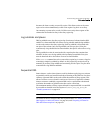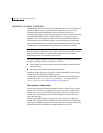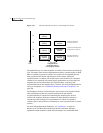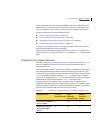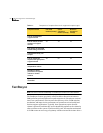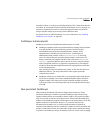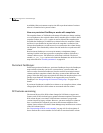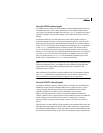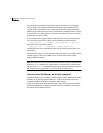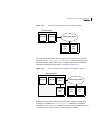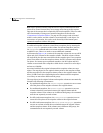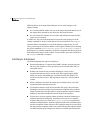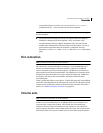
69Understanding Veritas Volume Manager
FastResync
Version 0 DCO volume layout
In VxVM releases 3.2 and 3.5, the DCO object only managed information about
the FastResync maps. These maps track writes to the original volume and to
each of up to 32 snapshot volumes since the last
snapshot operation. Each plex
of the DCO volume on disk holds 33 maps, each of which is 4 blocks in size by
default.
Persistent FastResync uses the maps in a version 0 DCO volume on disk to
implement change tracking. As for non-persistent FastResync, each bit in the
map represents a region (a contiguous number of blocks) in a volume’s address
space. The size of each map can be changed by specifying the dcolen attribute
to the
vxassist command when the volume is created. The default value of
dcolen is 132 1024-byte blocks (the plex contains 33 maps, each of length 4
blocks). To use a larger map size, multiply the desired map size by 33 to calculate
the value of dcolen that you need to specify. For example, to use an 8-block
map, you would specify dcolen=264. The maximum possible map size is 64
blocks, which corresponds to a dcolen value of 2112 blocks.
Note: The size of a DCO plex is rounded up to the nearest integer multiple of the
disk group alignment value. The alignment value is 8KB for disk groups that
support the Cross-platform Data Sharing (CDS) feature. Otherwise, the
alignment value is 1 block.
Only traditional (third-mirror) volume snapshots that are administered using
the
vxassist command are supported for the version 0 DCO volume layout.
Full-sized and space-optimized instant snapshots are not supported.
Version 20 DCO volume layout
In VxVM 4.0 and later releases, the DCO object is used not only to manage the
FastResync maps, but also to manage DRL recovery maps (see “Dirty region
logging” on page 60) and special maps called copymaps that allow instant
snapshot operations to resume correctly following a system crash.
Each bit in a map represents a region (a contiguous number of blocks) in a
volume’s address space. A region represents the smallest portion of a volume for
which changes are recorded in a map. A write to a single byte of storage
anywhere within a region is treated in the same way as a write to the entire
region.
The layout of a version 20 DCO volume includes an accumulator that stores the
DRL map and a per-region state map for the volume, plus 32 per-volume maps
(by default) including a DRL recovery map, and a map for tracking detaches that
are initiated by the kernel due to I/O error. The remaining 30 per-volume maps



